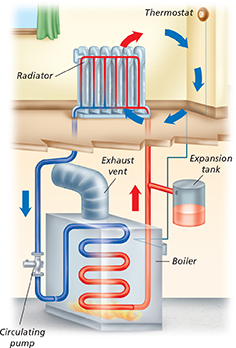Heating Systems
At the start of the industrial revolution, wood-burning fireplaces were the principal method of heating buildings. Rumford was keenly aware of the drawbacks of fireplaces. They were smoky and not very efficient. Too much heat went up the chimney. In 1796, Rumford designed a fireplace that now bears his name. His fireplace was not as deep as standard fireplaces, and it had slanted walls to reflect heat into the room. His improvements were quickly accepted and used throughout England.
Today, fireplaces are often used to supplement central heating systems. A central heating system heats many rooms from one central location. The central location of a heating system often is in the basement. The most commonly used energy sources for central heating systems are electrical energy, natural gas, oil, and coal. Heating systems differ in how they transfer thermal energy to the rest of the building.  Most heating systems use convection to distribute thermal energy.
Most heating systems use convection to distribute thermal energy.
Hot-Water Heating
Figure 13 shows the main components of a hot-water heating system. At the boiler, heating oil or natural gas burns and heats the water. The circulating pump carries the hot water to radiators in each room. The hot water transfers thermal energy to the radiator by conduction. As the pipes heat up, they heat the room air by conduction and radiation. Hot air rises and sets up a convection current in each room. After transferring much of its thermal energy to the room, the cooled water returns to the boiler and the cycle begins again.

Figure 13 Within the pipes of this hot-water heating system, the water circulates in a convection current. In each room, the air moves in a convection current.
Relating Cause and Effect Why has the water returning to the boiler cooled down?
Temperature is controlled by a thermostat. One kind of thermostat is like a thermometer, with a strip of brass and steel wound up in a coil. When the heating system is on, the coil heats up. The two metals in the coil expand at different rates, and the coil rotates. This trips a switch to turn off the heat. As the room cools, the coil rotates in the opposite direction, until it trips the switch to turn the heat back on.
Steam Heating
Steam heating is very similar to hot-water heating except that steam is used instead of hot water. The transfer of heat from the steam-heated radiator to the room still occurs by conduction and radiation. Steam heating often is used in older buildings or when many buildings are heated from one central location.





